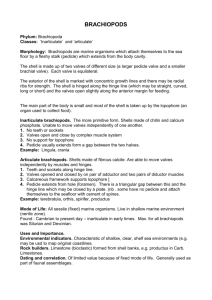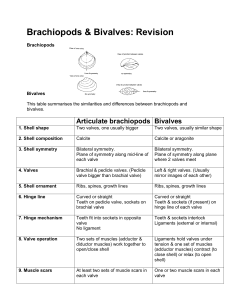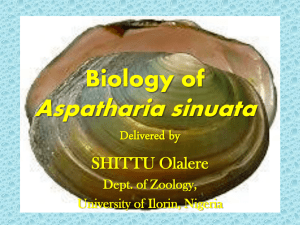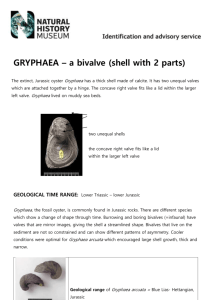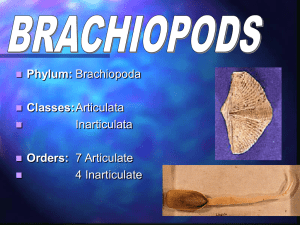Fossil Groups
advertisement
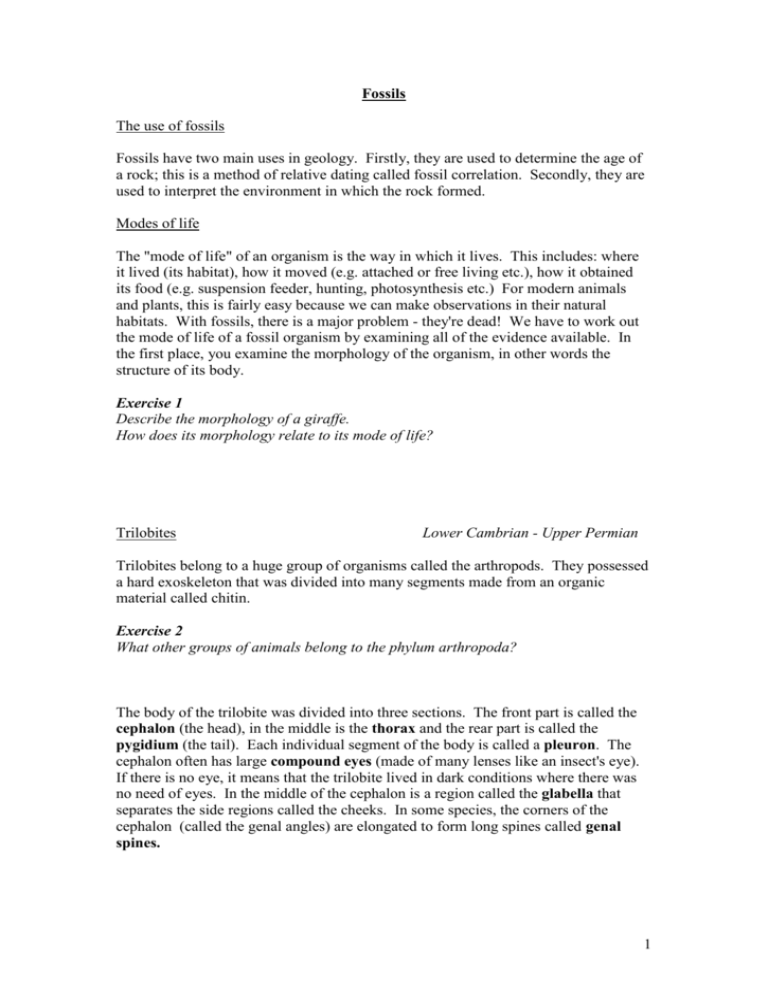
Fossils The use of fossils Fossils have two main uses in geology. Firstly, they are used to determine the age of a rock; this is a method of relative dating called fossil correlation. Secondly, they are used to interpret the environment in which the rock formed. Modes of life The "mode of life" of an organism is the way in which it lives. This includes: where it lived (its habitat), how it moved (e.g. attached or free living etc.), how it obtained its food (e.g. suspension feeder, hunting, photosynthesis etc.) For modern animals and plants, this is fairly easy because we can make observations in their natural habitats. With fossils, there is a major problem - they're dead! We have to work out the mode of life of a fossil organism by examining all of the evidence available. In the first place, you examine the morphology of the organism, in other words the structure of its body. Exercise 1 Describe the morphology of a giraffe. How does its morphology relate to its mode of life? Trilobites Lower Cambrian - Upper Permian Trilobites belong to a huge group of organisms called the arthropods. They possessed a hard exoskeleton that was divided into many segments made from an organic material called chitin. Exercise 2 What other groups of animals belong to the phylum arthropoda? The body of the trilobite was divided into three sections. The front part is called the cephalon (the head), in the middle is the thorax and the rear part is called the pygidium (the tail). Each individual segment of the body is called a pleuron. The cephalon often has large compound eyes (made of many lenses like an insect's eye). If there is no eye, it means that the trilobite lived in dark conditions where there was no need of eyes. In the middle of the cephalon is a region called the glabella that separates the side regions called the cheeks. In some species, the corners of the cephalon (called the genal angles) are elongated to form long spines called genal spines. 1 Exercise 3 In the space below, sketch a typical trilobite (such as the one shown on page 213 in McLeish). There were many types of trilobites, most seem to have lived in shallow seas often living on the sea bed. They possessed legs on each segment of the thorax that allowed them to crawl across the sediment. Trace fossils have been found which show trilobite walking tracks and resting marks. Most probably they searched for food in the sediment or hunted for smaller prey. There were two parts to each leg, the lower part was the walking limb, the upper part was a gill branch used for breathing, and in some types, for swimming. In some types of trilobites, the number of thoracic segments changed through time. These changes were slow and steady, so that the number of segments slowly increased one at a time. This has been used as evidence for evolution working in a gradual way. Exercise 4 Read the descriptions of the following trilobites. Use the evidence from the morphologies to support the interpreted mode of life. Look up pictures of these trilobites in a textbook. Paradoxides Morphology = Large (16 cm), heavy exoskeleton, large semicircular compound eyes. Long spines on each pleuron. Interpreted mode of life = Did not swim, crawled on soft sea bed in shallow water. 2 Agnostus Morphology = Small (1cm), few thoracic segments, pygidium and cephalon both broad and flat. Interpreted mode of life = Floated or swam in the deep sea. Trinucleus Morphology = 3.5 cm, semicircular cephalon with a wide brim. Long genal spines project backwards beyond the end of the body. No eyes. Interpreted mode of life = Burrowed in mud searching for food. Bivalves Lower Cambrian - Recent Bivalves belong to another large group of invertebrates called the molluscs. At the present time they are very common, most of the shells you find at the beach come from bivalves. Exercise 5 What other groups of organisms belong to the phylum mollusca? The bivalves have a shell made of two halves called valves which are usually the two valves are symmetrical. The valves meet along the hinge line which has a number of teeth and sockets so that the two valves articulate correctly. Along the hinge line is a tough elastic material called the ligament, this acts like a spring keeping the shell open. Each valve has a pointed tip called an umbo, if you hold the shell with the umbones pointing away from you, the left valve is on your left and the right valve is on your right. To close the shell, the animal had to pull the two valves together using powerful adductor muscles. These have left scars on the internal surface of the shell. The soft tissue was attached to the shell along a line which is often seen on the internal surface, called the pallial line. In some species, there is a "dent" in this line, called a pallial sinus. In some species of bivalve, the two valves do not meet tightly all the way around the shell, there may be a gap called a gape. The water is drawn over the gills which is the organ responsible for feeding and respiration. 3 Exercise 6 Draw and label a typical bivalve (e.g. see McLeish page 197). Show both the internal and external views. On the external view, draw and label the plane of symmetry. Bivalves have many different modes of life. They all live in water; many in the sea, but some in freshwater too. Some bivalves live attached to rocks or the sea bed, some like the oyster do this by secreting their shell directly onto the surface of the sea bed, others produce tough protein strands (like mussels). Bivalves which lived buried in the sediment need a way of getting clean water into their bodies and they do this using fleshy tubes called siphons. One siphon is for drawing in clean water, the other is for squirting out dirty water and faeces. If the animal burrowed deeply, it would need long siphons and this is why these animals had a pallial sinus, this is the place where the siphons were in the shell. This is also the reason for the gape - a space to let the long siphons emerge from the shell. The muscle scars may be the same size or they may be different sizes. Those bivalves with similar sized muscle scars tend to crawl across the sediment or burrow into it. Bivalves such as the mussel have differently sized muscle scars; the oyster (which also attaches itself to rocks) and the scallop (which swims by clapping the valves together) have only one muscle scar. Brachiopods Lower Cambrian - Recent Brachiopods are often confused with bivalves because they also have a shell made of two valves, but they are only found in the ocean and tend to live on the sea bed. These two valves are not symmetrical. The larger one is called the pedicle valve, it often has an opening (called the pedicle foramen) in the umbo to let a feshy stalk called the pedicle emerge. This is what attaches the animal to the rock or sea floor. The smaller valve is called the brachial valve. Like bivalves, the valves meet along the hinge line but in the case of brachiopods there is no ligament to open the shell. Instead a set of muscles is needed to open the shell (the diductors) and close the shell 4 (the adductors), so there are two sets of muscle scars. There are no siphons, but some types have adapted the edge of the shell to separate clean and dirty water. The clean water passes over a feathery organ called the lophophore which is resposible for respiration and feeding. Exercise 7 Draw and label a typical brachiopod shell (e.g. see page 191 in McLeish). On your diagram, draw and label the plane of symmetry. Brachiopods which were attached to the sea bed by means of a pedicle must possess a pedicle foramen. Some brachiopods developed shells which were thick, heavy and covered in spines. These adaptations were designed to anchor it in the sediment and there was no need of a pedicle. Ammonites Lower Devonian - End of the Cretaceous This is a famous group of fossil molluscs. Their closest living relative is a creature called Nautilus and we have inferred a lot about the ammonites mode of life through studying this animal. This group possessed a coiled shell, each coil of which is called a whorl. The shell has chambers separated from each other by walls called septa. The body of the animal resembled a squid and rested in the last chamber, called the body chamber. The other chambers contained gas. These chambers were connected to the animal's body by a tube called the siphuncle, which passes through holes in the septa. The septa meet the outer part of the shell and form a pattern called the suture line. In many ammonites this pattern is very complex, becoming more so as evolution progressed. The outer part of the shell bears ornamentation such as ribs and bumps (tubercles) and the edge of the shell may be flattened to form a keel (like a boat). 5 Exercise 8 Draw and label the internal and external appearance of the ammonites (or Nautilus as on page 199 in McLeish). All of the ammonites lived in the sea as free swimmers, probably catching prey with their tentacles and avoiding large marine predators by swimming quickly using a form of jet propulsion. The gas-filled chambers provided buoyancy and the weight of the body kept the animal in the correct flotation position. The keel was probably a means of maintaining stability. Corals Ordovician - Recent Corals belong to the same group of simple marine organisms as the sea anemones. They have a simple, soft body (called a polyp) which secretes a cup in which the animal lives. The mouth is in the centre, surrounded by tentacles which trap food, drawing it into the mouth. There is no anus so the faeces are sent out of the mouth. The cup-like skeleton is divided up by vertical walls called septa and horizontal "shelves" called tabulae. In the centre of this skeleton is a vertical column called the columella. Some corals exist as single animals and so are called solitary, many others, however, are colonial, in other words the coral skeletons grow together to make a large colony. In this way, coral reefs may be created. 6 Exercise 9 Draw and label a diagram of a typical coral. (e.g. see page 210 in McLeish) Much of what we know about fossil corals comes from studying modern corals. Reef corals are very sensitive to the environmental conditions. They cannot tolerate water temperatures below 18 C and the water must be less than 90m deep. Corals require normal salinity and clear, well oxygenated water. The reason for this is that the coral animal has a symbiotic relationship with unicellular algae. The algae require warmth, light and carbon dioxide for efficient photosynthesis and the host polyp benefits from a supply of oxygen and removal of carbon dioxide and other waste products. Graptolites Cambrian - Carboniferous Graptolites are a strange group of organisms with no modern equivalents; this makes interpreting their mode of life very difficult. They are colonial, marine organisms. Each individual is called a zooid and it lives in a cup called a theca, these thecae are arranged in a row called the stipe. At the top of the stipe is a narrow spine called a nema. Exercise 10 Draw and label a diagram of a typical graptolite (e.g. see page 194 in McLeish). 7 Geologists suggest that these organisms lived floating in the ocean, possibly attached to other floating objects by means of the nema. There was no obvious way in which they could move under their own power. During feeding, the zooids extended out of the thecae filtering the surrounding water for food particles. Plants Precambrian - Recent The most ancient types of plants are algae and it is possible to find traces of algae from 3500 million years ago (called stromatolites). Plants did not colonise the land until the Silurian period. Plant fossils include leaves, stems, roots, seeds/fruits and pollen. The most common plant fossils in Britain are those from the Carboniferous period. They represent swamp conditions which eventually formed the coal which is mined in Britain today. Exercise 11 Make sketches of the following common fossil plants: Stigmaria (root) Seed fern e.g. Neuropteris (leaves) Lepidodendron (stem) 8
